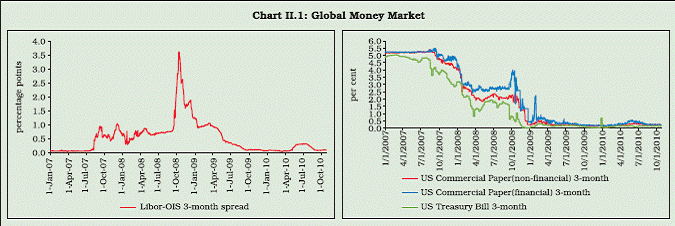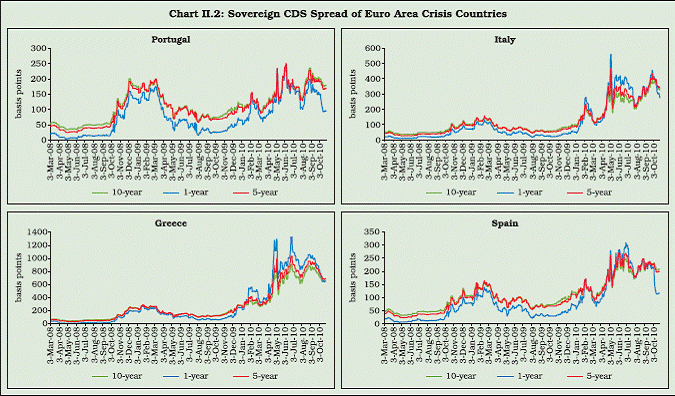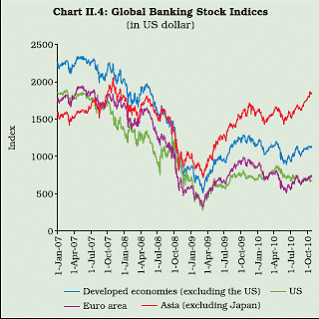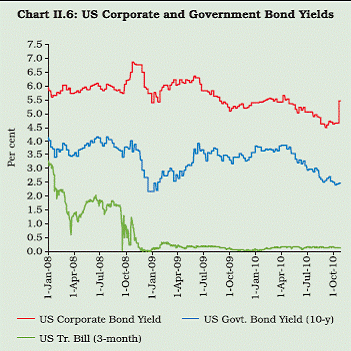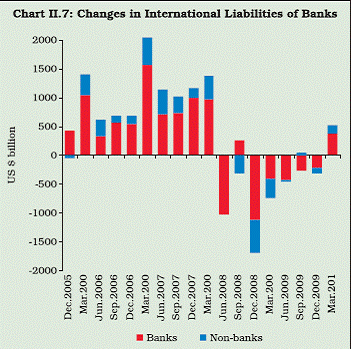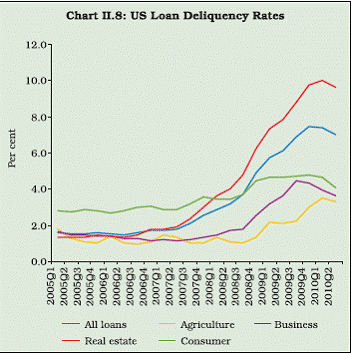Global Banking Developments - আরবিআই - Reserve Bank of India
Global Banking Developments
The global banking industry showed some improvements in performance during 2009-10, after witnessing a tumultuous period of large income losses and write downs in the wake of global crisis in 2008-09. Though the large scale monetary and fiscal stimulus measures led economic recovery and the revival of equity markets helped the global banking industry in terms of strengthening capital and liquidity and improving profitability, various concerns over downside risks to the global banking industry remained in regard to the quality of banks’ assets and profitability. Keeping in view the higher capital charge proposal under the enhanced Basel II framework, the global banking industry in some regions especially in the Euro area may witness further challenges to recapitalisation over the coming years as private sector funding matures and extraordinary public support is withdrawn. 1. Introduction 2.1 The global banking industry, after witnessing severe setback in terms of large income losses and write downs due to the global financial crisis in 2008, showed some improvement in performance in 2009. A major positive development in the aftermath of the global crisis was that during the first three months of 2010, the international claims of global banking industry rose for the first time since the third quarter of 2008. While the unprecedented monetary and fiscal stimulus measures by the central banks and the national authorities helped the banking industry to recoup capital and liquidity, the rise in asset prices that followed economic recovery in the first half of 2009 helped the banking industry return to profitability. However, the concerns remained with respect to the quality of profits, which were driven by trading in currency and fixed-income instruments. 2.2 Though the global banking business is now in much better shape than it was at the time of the crisis, the need for raising large amounts of capital for de-risking and for partaking normal borrowing and lending operations continues. According to the IMF’s World Economic Outlook (WEO), July 2010, despite the reduction in estimated loan losses, the uncertainty surrounding future expected delinquencies cast doubts on whether loan losses have finally abated. Going forward, pressures on the funding side are expected to impede bank lending due to deleveraging, underlining the need for strengthening capital and liquidity buffers. The rise in income of the global banking industry that was observed in 2009 halted in the second quarter of 2010 as a consequence of the spillover of the sovereign debt crisis in euro area with increasing fears that bank earnings could be affected going forward. 2.3 According to the Bank of England Financial Stability Report (FSR), June 2010, banks internationally face substantial refinancing challenge over the coming years as private sector funding matures and extraordinary public support is withdrawn. Globally, banks are estimated to have at least US $ 5 trillion of medium to long term funding maturing over the next three years. According to the Bank for International Settlements (BIS) Annual Report 2009-10, the global banking system remains vulnerable to further losses and the disruption in funding markets has the potential to choke refinancing channels when sentiments turn adverse. At the same time, the concurrent reforms contemplated in respect of the enhanced Basel II capital regime and other regulatory initiatives being taken to strengthen the financial systems also have implications for the banking industry which may witness the reduction in liquidity and costly credit for the borrowers. The implications of these reforms have been adjudged by international institutions, which provide different estimates of forgone output growth (IIF, 2010; BIS, 2010). 2.4 Unlike the advanced economies, the banking system in the emerging market economies (EMEs) remained resilient during crisis except for the knock-on impact through trade and financial channels which affected economic growth due to the fall in export demand and drying up of overseas financing possibilities. As the impact of the crisis gradually waned, the EMEs recovered swiftly and regained growth momentum while providing support to global demand. Capital inflows into the EMEs have resumed, leading to significant rebound in equity markets since early 2009. The banking systems in most of the EMEs remained well capitalised and profitable. 2.5 In India, the economic recovery gained strength on the back of a variety of monetary policy initiatives taken by the Reserve Bank and fiscal stimulus measures by the Government which aimed at stimulating aggregate demand. However, going forward the continuing weakness in global economy poses downside risks, particularly through adverse implications on trade and financing channels. 2. Global Macroeconomic Scenario 2.6 Global economy, after declining by 0.6 per cent in 2009, witnessed a significant recovery during the first half of 2010. The IMF 3. Global Financial Markets 2.7 Monetary conditions remained easy with central bank policy rate expectations remaining anchored at low levels. By April 2010, financial markets in advanced and emerging market economies staged a remarkable recovery. Interbank lending rates and developing country bond spreads returned to close-to-normal levels. Stock markets in high-income and emerging market economies recovered much of the value they lost and most developing-country currencies regained their pre-crisis levels against the dollar, with some having appreciated. While the most acute market strains receded, market confidence became fragile by mid-2010 as renewed funding constraints emerged in the wake of the sovereign debt crisis. The IMF’s composite volatility index, comprising implied volatilities derived from options on various stock market indices, interest rates and exchange rates, climbed sharply in May 2010. By July 2010, market stress was somewhat relieved and the safe haven assets such as US treasuries, German bonds and gold gained in value resulting in declining volumes in the money market. The intensification of sovereign risks in the euro area in the early part of 2010 also showed signs of some abatement by end-May 2010 with the announcement of European Stability Fund and the liquidity support program of the ECB. The sovereign spreads for countries with large rollover needs such as Spain and Italy, however, continued to be at significantly elevated levels. Money Market 2.8 While the drop in money market volumes in 2008 was caused by liquidity hoarding, and counterparty and collateral concerns, the unprecedented policy actions undertaken by central banks and governments worldwide during 2009 succeeded in stabilising the money market conditions by reducing funding pressures and counterparty risk concerns. The interbank markets returned to resumed functioning in the first quarter of 2010 as evidenced by the narrowing of the spread between LIBOR and overnight index swap (Chart II.1). Continued quantitative credit- easing, liquidity support measures and government guaranteed funding programmes helped improve the functioning of short term money markets and allowed some recovery in securitised market. As a result monetary and financial conditions softened further, reversing the sharp tightening of spreads observed earlier. This was accompanied by decline in market and liquidity risks as asset prices continued to recover across a range of asset classes. Although LIBOR-overnight index swap (OIS) spreads had narrowed by end-April 2010, there were indications that money markets had yet not returned to normal functioning. This was evident from the contributions of LIBOR and EURIBOR panel banks to their respective benchmarks remaining more dispersed than before the crisis. Subsequently, the unfolding of the sovereign debt crisis around mid-2010 led to severe inter-bank funding strains due to increased counterparty concerns resulting in a widening of longer term LIBOR-overnight index swap (OIS) spreads.
Sovereign Spreads 2.9 The combination of large-scale fiscal stimulus, financial rescue packages and falling tax revenues led to historically large government budget deficits and heightened levels of actual and projected public debt in most industrial countries especially in the
Equity Markets 2.10 Equity markets in advanced countries and those in emerging markets moved more or less in tandem, reflecting greater integration (Chart II.3). The extraordinary stimulus measures provided by the national authorities to safeguard financial stability and foster economic recovery helped global stock markets to recoup losses in 2009. However, the revelation of the depth and the impact of the sovereign debt crisis that surfaced to the fore by March 2010 led to renewed weakness in global stock markets. The equity markets in emerging market economies including India experienced revival of capital inflows and firming up of stock prices during the first half of 2010 as a result of quicker turnaround in economic prospects backed by the strength of internal demand. By the end of the first half of 2010, the impact of the sovereign crisis coupled with continued weakness in economy recovery in the developed world led to an overall global downtrend, although selective markets primarily in EMEs still continued intermediate uptrend.
2.11 The trends in banking stocks in 2009-10 reflected the strength of global macroeconomic environment as well as the challenges to the financial system (Chart II.4). In the advanced economies including the euro area and the US, banking stocks could not recoup to their pre-crisis levels. However, in the EMEs, especially in Asia, bank stocks showed a sharp recovery to reach almost the pre-crisis level due to strong balance sheets and growth prospects.
Bank CDS Market 2.12 Average bank credit default spreads increased sharply in early April 2009 for the US, UK and euro area banks but subsequently continued to soften during much of the 2009 (Chart II.5). The CDS spreads for the US banks continued to remain moderate in 2010. The CDS spreads for the euro area banks climbed sharply beginning April 2010, reflecting the uncertainty about the impact of the unfolding sovereign debt crisis in Europe and the recognition for euro area banks’ exposure to the crisis countries in the area. The greatest impact was on credit spreads for banks headquartered in the countries whose perceived credit worthiness had deteriorated the most especially in Greece, Portugal and Spain. In India, the CDS spread of some banks, which came under pressure in 2008, showed a significant softening of the trend during 2009-10.
Credit Market 2.13 In the wake of global crisis, growth in bank credit to the private sector decelerated in mature economies, securitisation markets outside those supported by the public sector remained weak and lower quality borrowers lacked any access to capital market funding. Bank lending continued to remain restricted, despite unconventional policies aimed at reviving credit to end users (Table II.2). Despite credit and quantitative easing policies, global real private borrowing rates as proxied by borrowing rates and yields on housing, consumer, and corporate loans and securities, weighted by the respective shares of outstanding debt, remained stable since April 2009. Furthermore, the public sector interventions that helped reduce the private sector risks resulted in increased public sector indebtedness and risks of fiscal failures. However, by October 2009, market and liquidity risks fell as interbank markets and some channels of private wholesale funding markets reopened and market volatility declined as worries of systemic collapse and economic failure abated. Financial institutions were no longer fully reliant on government guarantees for funding and were able to raise senior unsecured debt funding. Stronger banks faced no difficulty obtaining medium- to long-term funding in any major currency. However, some weaker banks were less able to access interbank and capital markets or only at penal rates.
2.14 Going forward, credit recovery will respond slowly as banks were still engaged in repairing their balance sheets. Notwithstanding the signs of some recovery in private credit demand, the sharp rise in sovereign funding needs entails that policy measures are swiftly initiated to address capacity constraints. The growth in private credit in the foreseeable period may continue to be weak as lending is overweighed by financing constraints and sovereign demands. As non bank finance is only a partial substitute of bank finance, households and SMEs which are largely reliant on bank lending may face credit constraint. The overall credit conditions moreover are expected to weaken as the central banks initiate progressive withdrawal of liquidity support provided by them. Corporate Bond Market 2.15 The corporate bond markets returned to normal functioning in 2010 (IMF, Global Financial Stability Report (GFSR) July 2010). However, due to tightening of the bank credit market, corporate credit and asset-backed securities spreads tightened and issuances rose as firms sought alternatives to depleting bank credit. High-yield issuance also increased but was restricted to higher quality credit and spreads remained historically wide. Although the gap between short-term interest rates and private borrowing rates was at its widest level since the beginning of the crisis, the risk appetite showed an increasing propensity due to improved investor confidence and declining counterparty risks as global real private borrowing rates of corporate loans and securities stabilised compared to the first half of the year. However the threat of sovereign debt spillovers which led to market turbulence during April 2010 caused sharp widening of credit spreads on non-financial corporate bonds resulting in near collapse of bond issuance especially by European firms. With signs of US recovery seen during the first half of 2010, the corporate bond spreads moderated to some extent (Chart II.6). The emerging market countries in Asia, Latin America, Europe, Middle East and Africa also experienced tighter financing conditions since May 2010 due to heightened risks in the euro area resulting in the virtual stoppage of issuances of corporate bonds and equity, although some regions were less affected than others. Continuation of these tighter conditions could begin to have impact on the availability of credit to private firms.
4. Global Banking Developments 2.16 A significant positive development pertaining to the global banking industry was that the contraction of BIS reporting banks’ international balance sheets that had begun in the fourth quarter of 2008 came to an end during the first three months of 2010 (Chart II.7). According to the BIS (Quarterly Review, September 2010), the turnaround was led by sizeable increases in international claims on residents of the United Kingdom and the United States. It was also boosted by continuing acceleration in cross-border claims on Asia- Pacific and Latin America and the Caribbean, which were the first two regions to experience positive post-crisis growth in international lending in the second quarter of 2009. Claims on the euro area and on emerging Europe continued to decline. Nevertheless, internationally active banks increased their exposures to Greece, Ireland, Portugal and Spain, mainly as a result of rising off-balance sheet items.
2.17 Despite generally improved economic conditions and a long period of healing after the failure of Lehman Brothers, progress towards global financial stability experienced setback in April and May 2010 with the emergence of euro area sovereign debt stress. According to the IMF, the huge refinancing need of close to Euro 300 billion for maturing bonds in the PIIGS (Portugal, Ireland, Italy, Greece and Spain) countries has the potential to spill over to other regions and re-establish an adverse feedback loop with the economy. Thus, further decisive follow-up of the significant national and supranational policy responses already taken would be required to be strengthened to instill confidence in the financial system and ensure continuation of the economic recovery. Going forward, the large and significant rollover needs in the PIIGS would create insurmountable pressure on bond markets as simultaneous funding needs of the United States, United Kingdom, Japan, and other Eurozone of the order of about US $ 4 trillion for bonds due for redemption in the third and fourth quarters come to fore. This implies that banks will face extreme difficulties in managing portfolio risks especially in the Eurozone, and the expected turbulence has already dampened the primary market for bonds of financial institutions. 2.18 The BIS Annual Report 2009-10 noted that banks returned to profitability and strengthened their capital ratios in 2009 (Table II.3). However, banks’ profits continued to be largely dependent on poor quality revenue from fixed income and currency transactions. Going forward, banks would have to address three major challenges, namely, refinancing a large portion of their liabilities, ending their dependence on emergency support measures by the public sector and redressing balance sheet weaknesses and reducing operating costs.
2.19 The IMF’s GSFR of October 2009 estimated that for the period 2007-10, the total write downs and loan provisions of the global banking system would amount to nearly US $ 2.8 trillion due to the problem of loan losses (Table II.4). The write downs and loan provisioning requirements for US banks were at the highest level aggregating US $ 1.025 trillion followed by euro area banks at US $ 0.814 trillion and UK banks at US $ 0.604 trillion. The GSFR for April 2010, however, reduced the size of estimated global write downs and loan provisions from US $ 2.8 trillion to US $ 2.3 trillion taking account of the estimated decline in the implied cumulative loss rate from 5.0 per cent to 4.1 per cent. Despite this moderation, there is little evidence to suggest that losses have finally abated due to the uncertainty surrounding the estimates of delinquencies as a result of differences in accounting procedures, reporting lags across regions, uncertain path of future delinquencies and covert concealment of losses through extension of maturities of loans sold by banks.
2.20 Central bank support and capital injections in the banking system by governments helped banks to recover from the crisis and return to profitability in 2009 due to rising asset prices and trading incomes. Banks were also able to raise capital worth US $ 1,236 billion thereby compensating actual losses of US $ 1,306 billion incurred till mid-2010. By the end 2009, and with the new capital raised by banks, the capital composition of US and European banks also showed qualitative improvement as Tier I capital rose to its highest level in 15 years due to slower growth in private credit and shift to government securities and other liquid assets US Banking System 2.21 The U.S. commercial banking sector remained under significant pressure in 2009, though the stress tests conducted by the Treasury in the first quarter of 2009 helped in steadying investor sentiments and reducing volatility and market uncertainty. The Supervisory Capital Assessment Program (SCAP) was undertaken by the Federal Reserve and other US supervisors in May 2009 to measure how much of an additional capital buffer, if any, each banking institution would need to establish at that time to ensure that it would have sufficient capital if the economy weakened more than expected. The results of the stress tests for 19 largest US bank holding companies conducted by the Federal Reserve in coordination with other bank supervisors in May 2009 suggested that additional capital of US $ 75 billion was required to restore the confidence in the financial system. 2.22 Despite the subdued credit market, the profitability of US banks improved in the first quarter of 2010 as many banks reported tentative improvements in credit quality. Asset quality for all major loan classes in the US banks showed a moderation of the trend in 2010 (Chart II.8). In particular, the four largest bank holding companies recorded profits in the first quarter of 2010, as trading revenue and lower loss provisioning boosted earnings. Regional and smaller banks, however, continued to struggle with profitability as credit losses on core lending operations remained high. Moreover, failures of smaller banks continued in 2010 at about the same pace as 2009, driven largely by credit losses on commercial real estate lending.
The Eurozone Banking System 2.23 The financial performance of many euro area large and complex banking groups (LCBGs) strengthened in the first quarter of 2010 on the back of efforts made to improve the soundness of their balance sheets. The capital ratios of euro area LCBGs also improved in the first quarter of 2010 to 10.6 per cent from 10.1 per cent in 2009 due to support from retained earnings and efforts made to raise capital from public and private sources. As per the estimate provided by the ECB’s FSR of June 2010, the potential cumulative write-downs on securities and loans for the euro area banking sector for the period 2007 to 2010 at Euro 515 billion was lower than Euro 553 billion reported in the FSR December 2009. However, the progressive intensification of market concerns about sovereign credit risk in the euro area in the early months of 2010 opened up a number of hazardous contagion channels which led to adverse market dynamics taking hold of a range of asset markets by May 2010. According to the ECB’s FSR of June The UK Banking Industry 2.24 The slew of supportive measures taken by the Bank of England and the Exchequer in the form of special liquidity scheme, equity injections, credit guarantee scheme for bank liabilities and asset protection scheme for toxic assets helped to bring about a turnaround in the UK banking sector. The implied mark-tomarket losses of the UK banks in their banking books declined by about fifty per cent from the assessment in March 2009. The loan loss provisions for UK banking system were reduced by US $ 99 billion to US $ 398 billion by April 2010, reflecting improvements in expected losses on residential mortgages. Accordingly the projected loss provision rate for the first half of 2009 was revised downwards by the IMF in April 2010. The UK banking system took advantage of strong profitability and improved investor risk appetite in 2009 to strengthen their capital positions. The major UK banks raised more than £50 billion in additional core Tier 1 capital during the second half of 2009, taking the total to £127 billion since the start of the crisis. Core Tier 1 capital ratios at 9.6 per cent as at end-2009 exceeded the pre-crisis levels, but remained low when compared historically. 2.25 According to the Bank of England, FSR, June 2010, the capital and liquidity buffers notwithstanding, UK banks face a number of challenges in the period ahead. UK banks need to maintain resilience in a difficult environment, while refinancing substantial sums of funding. They have a collective interest in providing sufficient lending to support economic recovery and they will need over time to build larger buffers of capital and liquidity to meet more demanding future regulatory requirements. The new independent banking commission would recommend regulation and competition policies in 2011 which would foster competitive lending among banks and improve access to credit for small businesses. UK banks will need over time to build larger buffers of capital and liquidity to meet more demanding future regulatory requirements. Emerging Markets 2.26 In terms of profits, Tier I capital, dividend and market value, the emerging market banks constitute about 25 per cent of the global banking industry. Emerging markets banks are pre-eminent gatherers of savings unlike western banks that borrowed heavily to finance business and suffered significantly from the financial crisis. Banks in emerging Asia gained significantly from a favorable combination of macroeconomic circumstances such as a sharp rise in domestic savings and easy monetary policies that led to low cost financing. However, going forward credit and market risks may increase owing to larger scale of future lending and exposure to government bonds. 2.27 The largest economy in the emerging markets group, China has been witnessing a boom in bank lending despite the impact of the global financial crisis. Chinese banks lent a record US $ 1,415 billion in 2009 - more than double the new loans issued in 2008 despite the warnings by regulators that many of the loans used to fund infrastructure spending and property boom may go bad. According to the rating agency Standard and Poor, if 30 per cent of the loans to local government vehicles become bad, it would add 4 to 6 percentage points to overall non-performing loan ratio of banks which is presently at a respectable level. Losses could be magnified if the real estate exposures are also affected by delinquencies. The regulatory initiative to slow down bank lending by imposing loan lending quotas has had some effect on the Chinese economy with the GDP growth slowing down from 11.9 per cent in the first quarter of 2010 to 10.3 per cent in the second quarter. The Peoples Bank of China has indicated that it would strictly maintain its credit target for 2010 at US $ 1,127 billion. Banks have also been asked to put all loans sold or transferred to lightly regulated trusts back on their books and refrain from ‘informal securitisation’. This measure is expected to put 2.28 Banks in emerging markets such as Brazil and Russia have significantly improved their market share. According to the FSR issued by Banco Central do Brasil in April 2010, the consolidation of economic recovery in Brazil by the end of 2009 had positive influence on credit, liquidity, solvency and profitability in the domestic banking system. The degree of solvency of the Brazilian banking institutions as at end 2009 remained high given the holdings of significant amounts of high quality liquid assets. Raised capital and retained profits contributed to an increase in the Basel Capital adequacy ratio (CAR) by 0.2 percentage point and a reduction of leverage by 0.4 percentage point. The scenario analysis, based on stressed macroeconomic variables, indicated that the solvency of the Brazilian banking system would not be impacted in a relevant way. In this scenario, the CAR of the aggregate system is expected to reach 15.0 per cent in June 2011, well above the regulatory minimum of 11 per cent. The profitability of the banking system continues to remain satisfactory and resulted mainly from increased volumes of business and diversification of the sources of revenue. The quality of income has improved over time, given that the participation of non-operating income in the composition of the profit was lower than that verified in each of the previous quarters. 2.29 Russian banks have traditionally undertaken only few core activities such as attracting deposits, offering credit, managing risk to earn a profit, and performing efficiently such that value is created. The current crisis demonstrated that many Russian banks hoarded liquidity and did not perform their core activities well enough. However despite the current crisis, there continues to be strong potential for growth in the Russian banking industry. The Russian market for banking services remains largely underserved and is expected to grow at 15 to 20 percent through 2020. Asset management, leasing and mortgages are some of the key financial products that will drive the growth in Russian banking services in the next few years. 2.30 Other emerging Asian economies in general also made a quicker turnaround with improved prospects of growth in the next two years, although slower global growth, withdrawal of stimulus measures, sharp increase in international commodity prices and deteriorating fiscal positions pose downside risks to growth. The Gulf Area Banking Industry 2.31 The performance of investment banks in the Gulf region remains severely compromised owing to serious shortcomings in risk New Framework for Financial Stability 2.32 Explicit pursuit of financial stability is the single most significant take away from the recent global financial crisis. While multilateral and standard setting bodies are placing in revised global regulation norm, countries across the world are implementing new frameworks for ensuring financial stability (Box II.1). 5. Conclusions 2.33 To conclude, despite the improvements in terms of capital, liquidity and profitability witnessed by the global banking industry in 2009-10, concerns remained over various downside risks. The global banking industry continues to face significant challenges to cleaning its balance sheet in order to improve the quality of assets and profitability. According to the new bank capital rules under enhanced Basel II framework, banks will have to hold Tier I capital totaling 6 per cent of their riskbearing assets, an increase from the current requirement of 4 per cent. However, a long phase in period extending in part to 2019 has eased fears that lenders will have to rush to raise capital. Banks will not be required to meet the minimum core Tier-1 capital requirement, comprising shares and retained earnings, at 4.5 per cent until 2015. An additional 2.5 per cent capital conservation buffer will not need to be in place until 2019. Nevertheless, in line with the proposal of the BCBS for higher capital charge, the banking industry in some regions such as the euro area may witness challenges to recapitalisation, especially as countries in the euro area engage in the fiscal consolidation efforts in the future. Box II.1: Evolving Institutional Framework for Financial Stability Preserving financial stability over the long term requires implementing carefully designed framework that is effective and gains public support over time. Major countries have proposed to overhaul the institutional framework for financial stability. United States: The “Restoring American Financial Stability Act of 2010” signed by the President of the United States on July 21, 2010 would result in changes in the existing regulatory structure. The institutions affected by these changes include most of the regulatory agencies currently involved in monitoring the financial system (Federal Deposit Insurance Corporation (FDIC), Securities Exchange Commission, Comptroller of Currency, Federal Reserve, Securities Investor Protection Corporation, etc.), and the winding up of the Office of Thrift Supervision(OTS). To prevent regulatory competition and clarify regulatory duties, the Act divides the regulatory system into three distinct parts, with each part becoming the primary responsibility of a particular agency. The FDIC is responsible for state banks/thrifts with assets under US $ 50 billion whereas the Office of the Comptroller of Currency is responsible for national banks/thrifts with assets under US $ 50 billion. All other banks/thrifts, Bank Holding Companies (and institutions deemed necessary) will be the responsibility of the Federal Reserve. Certain non-bank financial companies and their subsidiaries will also be supervised by the Fed in the same manner and to the same extend as if they were a bank holding company. Three new agencies constituted by the Act include (i) Financial Stability Oversight Council (FSOC), (ii) Office of Financial Research (OFR) and (iii) Bureau of Consumer Financial Protection (BCFR) The FSOC and the OFR would be attached to the Treasury Department with the Treasury Secretary as the Chair of the FSOC, and the Head of the OFR being a Presidential appointment with Senate confirmation. On the other hand, the BCFR would be housed within the Federal Reserve System, and is tasked with regulating consumer financial products and services in compliance with federal law, and is required to report to the Senate Banking Committee and the House Financial Services Committee. The legislation entrusts responsibility of the Federal Reserve to “identify, measure, monitor, and mitigate risks to the financial stability of the United States.” The Fed would continue to establish prudential standards for the institutions under their supervision including capital requirements, leverage ratio, liquidity requirements, etc. United Kingdom: In 1997, the UK divided the supervision of the banking sector between the central bank, the Financial Services Authority (FSA) and the Treasury. However, given the ineffectiveness of this model in ensuring financial stability during the recent crisis, the country has now decided to reform the architecture of financial regulation with the proposed implementation of the ‘twin peaks’ model to divide the responsibilities of the Financial Services Authority (FSA). The responsibility of the FSA would be divided between a new prudential regulator which would be inside the Bank of England and a new consumer protection and markets authority. The focus of these changes would provide a new remit to the Bank of England to prevent the build-up of risk in the financial system in addition to its monetary policy role. Further, the reform also proposes to create a Financial Policy Committee with macro prudential oversight to prevent asset bubbles and managing systemic risk. Both the prudential regulatory authority and financial policy committee will be headed by the Governor, Bank of England bringing him at the centre of supervision of both individual banks and financial system. European Union: In the Eurozone, while the European Central Bank (ECB) is in charge of monetary policy, interventions on the foreign exchange markets and international and European cooperation, there are separate mechanisms in place for monitoring and assessment of financial stability. Presently, the Committee of European Banking Supervisors (CEBS) gives advice to the European Commission on policy and regulatory issues related to banking supervision. Since 2009, CEBS has been tasked to provide regular bank sector analysis and perform assessments on risks and vulnerabilities on the banking sector and report its outcomes periodically to the European Union political institutions. A need was, however, felt to improve the interplay between micro- and macro-prudential supervision with the establishment of a body that can undertake macro-prudential supervision of the EU financial system as a whole. The EU has therefore proposed the establishment of European Systemic Risk Board (ESRB) responsible for macro-prudential supervision in the EU. An important topic that would be on the ESRB’s agenda is that of the “Systemically Important Financial Institutions”(SIFIs). India: The Securities and Insurance Laws (Amendment and Validation) Bill was passed in August 2010, enabling the Government to constitute an apex Financial Stability and Development Council (FSDC) headed by the Finance Minister for the purpose of institutionalizing the mechanism for maintaining financial stability and resolving inter-regulatory disputes. A sub- committee of the Council with the mandate to look after financial stability and inter-regulatory coordination would be headed by the Reserve Bank Governor. The subcommittee would be the first stop for resolving any disagreement among regulators. In the post crisis scenario, the views on the preferable framework of regulatory architecture for financial stability have differed across countries. |
||||||||||||||||||||||||||||||||||||||||||||||||||||||||||||||||||||||||||||||||||||||||||||||||||||||||||||||||||||||||||||||||||||||||||||||||||||||||||||||||||||||||||||||||||||||||||||||||||||||||||||||||||||||||||||||||||||||||||||||||||||||||||||||||||||||||||||||||||||||||||||||||||||||||||||||||||||||||||||||||||||||||||||||||||||||||||||||||||||||||||||||||||||||||||||||||||||||||||||||||||||||||||||||||||||||||||||||||||||||||||||||||||||||||||||||||||||||||||||||||||||||||||||||||||||||||||||||||||||||||||||












